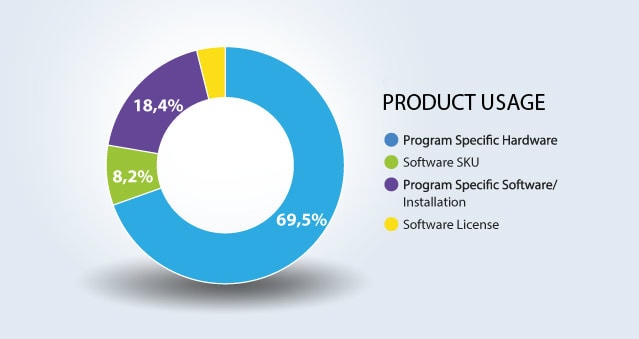In today’s rapidly changing, unpredictable world, recurring revenue has become the go-to business model for generating income. For this reason, companies across a variety of industries are shifting from a one-time sales model to the recurring revenue business model.
No longer limited to software-as-a-service (SaaS) businesses, subscription-based companies, or membership programs, it is being adopted across a variety of sectors such as property management, hardware, airlines, restaurants, and even car dealerships.
What is Recurring Revenue?
Recurring revenue is a business model that relies on repeat purchases that are billed at scheduled intervals – monthly, quarterly, or annually. Unlike one-time sales, it enables organizations to predict future revenue with a higher degree of accuracy and maximize earning potential. However, it’s important to note that there are no guarantees that recurring revenues will last over the long term.
Common Recurring Revenue Models
Although classified as a business model, recurring revenue is the overarching term for a variety of models. Let’s explore the six most common models.
- Standard or straight-up subscriptions: Well known for magazine subscriptions, this is the most basic type of subscription model. Offered for varying periods of time, the customer can cancel their product or service subscription at the end of the contract or renew the subscription
- Long-term or hard contracts: Typically used by satellite and cable companies, as well as internet service providers and cell phone companies, customers enter into a long-term contract (two-, three-, or even longer periods) in exchange for regular use of the service at a predetermined price that is paid monthly.
- Auto-renewing subscriptions: Also referred to as evergreen subscriptions since the subscription can go on indefinitely, the contract automatically renews at the same terms, unless the subscriber provides advance (usually 30 days) notice of cancellation. This recurring revenue model is widely used by companies that sell software as a service (SaaS), as well as streaming services, subscription boxes, and internet domain registration organizations.
- Sunk money: This recurring revenue business model consists of two variations – sunk money consumables and sunk money subscriptions. Sunk money consumables is the model businesses use when after a customer makes the initial investment additional purchases are required – think Brita water filter systems that are only compatible Brita filters, Clorox ToiletWands require Clorox cleaning refills, and certain coffee machines such as Nespresso require their brand of coffee pods. Sunk money subscriptions also require an initial purchase of a product. The most common example is that of the Bloomberg Terminal – a proprietary platform that is needed to subscribe to Bloomberg’s financial publications.
- Standalone product subscriptions: Consumers are creatures of habit and once they embrace certain brands and products, they are typically loyal. This recurring revenue model is best illustrated by the Dollar Shave Club.
- Freemium: Provides for a lifetime plan to free products or services however, to receive additional or advanced features or functionality customers need to upgrade to a paid plan. Many companies have adopted a freemium model due to its low entry barriers, making it a way to quickly acquire a sizable customer base. A few examples of companies that have been successful with the Freemium business model include Spotify and Dropbox.
While not an exhaustive list, the model truly is only limited by your imagination and innovation.
Benefits and Challenges to Consider
Companies that incorporate the recurring revenue business model boast a higher valuation. As explained by John Warrillow, author of The Automatic Customer, the value of organizations with a recurring business model can be up to eight times greater than that of their competitors that have no or very little recurring revenue. While a significant advantage, recurring revenue delivers additional benefits, as well as challenges.
Benefit | Description |
Predictable cash flow | Not as prone to market-based fluctuations as other revenue models, recurring revenue provides more precise metrics. This enables you to better forecast cash flow, improve expense budgeting, and plan for company growth. |
Customer loyalty | Customer retention is at the center of the recurring revenue model, meaning it takes less resources to acquire new customers. This provides the ability to deliver the kind of service customers expect, build brand loyalty, and upsell and cross-sell offerings to existing customers. Additionally, the longer a customer is with your company, the more difficult it becomes for them to switch to a competitor. |
Increased revenue | As mentioned above, loyal customers are more apt to upgrade plans and purchase additional features and functionality. Further, these loyal customers (over time) can become brand ambassadors, allowing you to expand your customer base and increase revenue. |
Lower entry barriers | Most recurring revenue businesses offer flexible payment options, enabling customers to make recurring payments for the products or services purchased. The smaller monthly or quarterly payments lessen the financial impact of the purchase and expands your prospect base. |
Increased validation | Recurring revenue model businesses never begin a month at zero dollars, typically have better control of their expenses, have a predictable and stable revenue stream, and enable you to predict monthly recurring revenue (MRR) and annual recurring revenue (ARR) more accurately, making recurring revenue businesses a favorite among investors. |
Challenge | Description |
Tracking recurring revenue | Tracking subscription-based revenue is more complicated than billing for single purchases. You can have hundreds or thousands of customers in different parts of their subscription cycle simultaneously. Managing revenue efficiently and accurately requires a flexible billing platform that can easily handle a variety of pricing models and scale as the business grows. |
Subscription dislike/fatigue | Not everyone is drawn to subscription-based buying and those prospects will likely make one-time purchases. The other consideration is customers that develop subscription fatigue from being presented with too many choices across an array of companies and industries. |
Customer expectations | With a business model that relies on customers committed to having a long-term relationship with you, it’s important that their expectations are not only met but exceeded, and they receive tangible value from the continued relationship with your organization and its products/services. |
Customer churn | Subscription cancellations happen and a certain percentage of churn can be expected. Given that customer retention is not an automatic byproduct of the recurring revenue business model, it is important to monitor churn rates and take action if you begin to lose more customers than you retain. |
How to Calculate Recurring Revenue
As two of the key metrics for recurring revenue businesses, determining accurate MRR and ARR is essential. The easiest way to arrive at MRR and ARR is with the following calculations.
MRR calculation
Add up the following:
- Subscription revenue from new customers
- Subscription revenue from existing customers
- Add-on and upgrade revenue from existing customers
Then subtract:
- Lost revenue from the removal of add-ons or plan downgrades
- Lost revenue from customer churn
This then gives you the monthly recurring revenue value. With the hard work done, ARR is determined using a simple formula.
ARR calculation: MRR x 12 = Annual Recurring Revenue
The differences between MRR and ARR are pretty straightforward. MRR provides a short-term, micro-level view of your recurring revenue by month and quarter, whereas ARR provides a long-term, macro-view of the business’s financial health.
We Can Help
Using a variety of strategies, companies across diverse sectors are adopting the recurring revenue business model. For example, last year Taco Bell took their initiative – Taco Lover’s Pass – nationwide. If a fast-food chain can incorporate recurring revenue, what’s stopping you?
If you’re not sure where to begin, we’re here to help. From a team of recurring revenue experts to a purpose-built, agile system that can handle even the most complex recurring revenue processes – BillingPlatform enables you to easily transition from simple one-time pricing models to creative and profitable recurring revenue plans. Are you ready to cash in on the recurring revenue business model? Our team of experts is ready to help you along the way, reach out today.



